| Click On Image For Full Size | Size | Image Description | Source | |
|---|---|---|---|---|
 0835530 | NR | Allyn Vine, 79, Dies, Proponent of Submersibles Allyn C. Vine, an oceanographer who was a leader in developing manned submersible vessels to explore the deep sea, died on Tuesday at his home in Woods Hole, Mass. He was 79. The cause was heart failure, said Shelley Lauzon, a spokeswoman at the Woods Hole Oceanographic Institution. Mr. Vine was a physicist, physical oceanographer and senior scientist at the institution for nearly 40 years, until his retirement in 1979. Contributed to War Effort Because of Mr. Vine's tenacity in pursuing the construction of submersibles, the first American manned research submersible for deep diving was named Alvin (DSV-2), a contraction of his name. When the vessel was christened in June 1964, Mr. Vine was unable to be present because he was three miles below the surface of the Atlantic Ocean aboard the French submersible Archimede. | Photo & text courtesy of The New York Times, 8 January 1994, pg.30@ timesmachine.nytimes.com | |
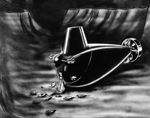 |
771k | This is the design of the new 10-ton, two-man undersea research vehicle to be constructed by General Mills, Inc., for Navy oceanographic research. The submersible, which can be carried aboard and operated from the Navy's existing oceanographic ships, will be operated by Woods Hole Oceanographic Institution as part of a research program supported by the Office of Naval Research. The 20-foot undersea craft, capable of depths of 6,000 feet which allows it to explore the Continental Shelf, will be completed in the summer of 1963 at a cost of $575,000. It will have a maximum speed of six knots, an endurance of 24 hours and a maximum range of 30 miles. The two-man crew and 1,200 pounds of scientific instrumentation will be contained in a spherical cabin or pressure hull similar to the steel sphere of the Navy's bathyscaph Trieste. Surrounded the sphere will be a free-flooding, cylindrical-shaped outside skin, including a five-foot conning tower, fabricated of reinforced fiberglass. The steel for the spherical pressure hull will be 1 Ĺ inch thick high-strength HY 100 steel. | USN photo # USN 711146, courtesy of the National Museum of the U.S. Navy, via flickr.com. | |
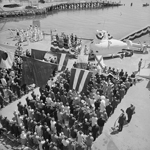 0835523 | 845k | Submarine Alvin (DSV-2) dedication, Woods Hole, MA., 29 May 1964. | Photo courtesy of digitalcommonwealth.org | |
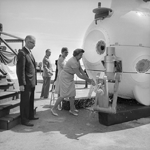 0835521 | 558k | Submarine Alvin (DSV-2) dedication, Woods Hole, MA., 29 May 1964. | Photo courtesy of digitalcommonwealth.org | |
 0835526 | 572k | Draped in bunting and with a Navy brass band playing, the new research submersible Alvin (DSV-2) was commissioned at the Woods Hole Oceanographic Institution dock on 5 June 1964. | Photo courtesy of (Jan Hahn/WHOI) at whoi.edu | |
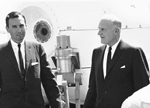 |
265k | The Deep Submergence Research Vehicle Alvin (DSV-2) was commissioned on 5 June 1964. Attendants included Mr. George Scharffenberger left, senior vice president of Litton Industries which built Alvin, and the Honorable James H. Wakelin, Jr. right, Assistant Secretary of the Navy Research Development. | Photo & text courtesy of wikipedia.org. | |
 0835504 | 311k | For its first 20 years, Alvin (DSV-2) traveled on and was launched from a tender ship, Lulu, named after the mother of Allyn Vine, the WHOI scientist after whom the sub is named. The catamaran was built from two surplus Navy pontoons. | Photo, Woods Hole Oceanographic Institution Archives at whoi.edu | |
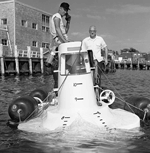 0835529 | 572k | Alvin (DSV-2) pilot Bill Rainnie (left) and Earl Hays, first chairman of the WHOI Department of Applied Oceanography, test the deep submergence research vehicle Alvin in 1964. They were key figures involved in the design, construction, testing, and utilization of Alvin. | Photo courtesy of (WHOI Archives) at whoi.edu | |
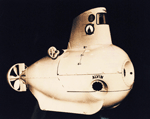 |
1.07k | The Navy research submarine, Alvin (DSV-2) was operated by the Woods Hole Oceanographic Research Institution for the Office of Naval Research. The craft is 29 feet long and weighs 11 tons. It has a molded fiber-glass hull, which houses 8,400 pound sphere, made of one-inch thick steel, in which the two men crew will ride. The sphere can be released in an emergency and will float to the surface. Alvin is expected to have continuous speed of four knots, six knots in short bursts and a maximum range of 25 miles. Alvin is named for Allyn C. Vine, a Woods Hole Oceanographic Research doctor, who was greatly responsible for the submarine's creation. Photograph released 24 June 1964. | USN photo # USN 1097019, courtesy of the National Museum of the U.S. Navy, via flickr.com. | |
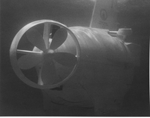 0835524 | 510k | Submarine Alvin (DSV-2) made its first deep dive to 6000 feet, 20 July 1965. It was piloted by William Rainnie of Woods Hole Oceanographic Institute. The dive was made off Andros Island in the Bahamas. | Photo USN 1112320 courtesy of history.navy.mil | |
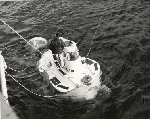 |
63k | US Navy Rearch Underwater Vessel Alvin (DSV-2) is lowered into the water off Palomares, Spain, during the search for a missing Air Force hydrogen bomb. Alvin, the two man research submarine, located the bomb five miles off-shore and it was pulled to the surface April 1965. | USN photo & text courtesy of USNI. | |
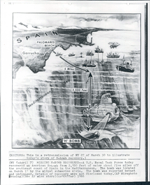 |
253k | Missing H bomb recovered by Alvin (DSV-2) off Palomares, Spain | AP Wire photo courtesy of Ron Reeves (of blessed memory) via Gary Priolo. | |
 |
115k | Aboard Petrel (ASR-14), off the coast of Spain, 1966; NOTS crew after successful recovery of "Robert" the H-Bomb(foreground,behind anchor), with Cable-controlled Undersea Recovery Vehicle (CURV) in the background (magazine photo). The recovered thermonuclear bomb was displayed by U.S. Navy officials on the fantail of the submarine rescue ship Petrel, after it was located in the Mediterranean Sea off the coast of Spain at a depth of 762 meters and recovered in April 1966. | Photo & text courtesy of wikimedia.org. & nawcwpns.navy.mil | |
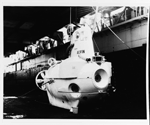 |
205k | Alvin (DSV-2) secured to the well deck of Fort Snelling (LSD-30) in March 1966. | USN photo USN-1115311 courtesy of history.navy.mil | |
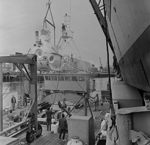 0835532 | 582k | Alvin (DSV-2), a deep submergence research vessel based at Wood's Hole, being hoisted from the San Marcos, 12 May 1966. | Photo courtesy of digitalcommonwealth.org | |
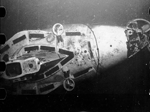 0835525 | 438k | In 1968, while Alvin (DSV-2) was being brought onboard its support ship, Lulu, a cable broke. With the hatch open, the submersible quickly filled with approximately 8000 pounds of water and sank in 5200 feet of water, 88 miles off the coast of Nantucket, Massachusetts. Photo taken from Aluminaut. | Photo courtesy of wikimedia.org | |
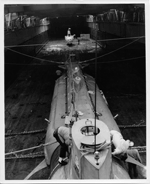 |
697k | Alvin (DSV-2) and Aluminaut in the well deck of either the Fort Snelling (LSD-30). The two submersibles were berthed together until Aluminaut's tender arrived. | Photo courtesy of the Naval Historical Center & text via writtenbybarbaramoran.com. | |
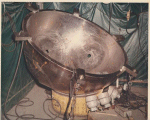 |
59k | Alvin's (DSV-2) three view ports welded into the hemispheres. This photo was taken after the completion of welding the third view ports and prior to removing the hemisphere from the welding enclosure to the machine shop for machining in 1972 at the Mare Island Naval Shipyard. | Photo & text courtesy of Jim Richardson. | |
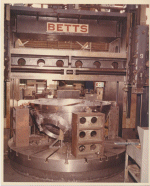 |
84k | The hemisphere set-up on the BETTS vertical mill for machining the weld joint prep for welding Alvin's (DSV-2) two hemispheres together. | Photo & text courtesy of Jim Richardson. | |
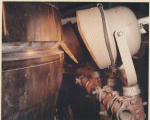 |
62k | Close-up of the weld joint during preheat and prior to welding. | Photo & text courtesy of Jim Richardson. | |
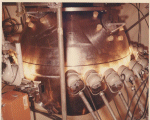 |
82k | The two hemispheres being preheated for welding to become the personnel sphere for Alvin (DSV-2). | Photo & text courtesy of Jim Richardson. | |
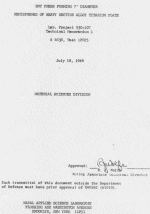 |
607k | Cover page of the 7 page PDF lab report on hot forming of the titanium plate to make the two hemispheres for the personnel sphere that is in Alvin (DSV-2). This is the same method used to form the titanium hemispheres used for Sea Cliff (DSV-4). | Photo & text courtesy of Jim Richardson. | |
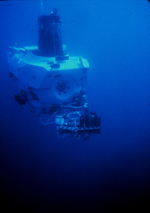 |
102k | Alvin (DSV-2) on August 1978, a year after first exploring hydrothermal vents. The rack hanging at the bow holds sample containers. | Courtesy of OAR/National Undersea Research Program (NURP); Woods Hole Oceanographic Inst via Robert Hurst. | |
 |
53k | Cut out of the Alvin (DSV-2). | Photo courtesy of Jack Treutle (of blessed memory). | |
 |
19k | Commemorative postal cover marking Alvin's (DSV-2) dive on the Titanic, 23 August 1995. | Courtesy of Jack Treutle (of blessed memory). | |
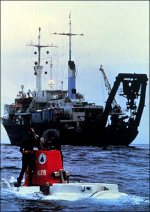 |
41k | Alvin (DSV-2), with divers aboard as she approaches her support ship Atlantis from the stern. | Courtesy of Woods Hole Oceanographic Institution. | |
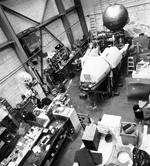 |
699k | Alvin (DSV-2) gets refitted with new personnel sphere, June 2008. | Photo courtesy of Office of Naval Research via Robert Hurst. | |
 |
608k | Panorama of Alvin (DSV-2) on the fantail of the aboard her support ship Atlantis following a dive, 19 July 2008. On the right side of the photograph the A-frame crane can be seen that lowers Alvin into the water and on the left, Alvin's hangar. | Photo courtesy Kirt L. Onthank (Taollan82) via Robert Hurst. | |
 New & Improved New & Improved |
||||
 0835528 | 402k | A preliminary view of the "new" Alvin (DSV-2), which was assembled at WHOI starting in the summer of 2012. | Illustration by Megan Carroll, Woods Hole Oceanographic Institution at whoi.edu | |
 0835531 | 402k | Alvin's (DSV-2) old sphere (left) had only one forward-looking viewport for the pilot, and so scientists looking out the port and starboard viewports could not simultaneously see what the pilots was looking at. The new sphere has three forward-looking viewports, with overlapping field of views for pilots and scientists. | Photo & text courtesy of (Matthew G. Barton/Woods Hole Oceanographic Institution) at whoi.edu | |
 0835527 | 402k | At 50, Alvin (DSV-2) Gets an Extreme Makeover Alvin is hoisted onto the deck of the research vessel Atlantis in May 2013. The sub was reunited with its tender ship after spending 29 months ashore, undergoing a sweeping overhaul that dramatically enhanced the subís capabilities. The new Alvin weighed about 10,000 pounds more than the old one. | Photo & text courtesy of (Tom Kleindinst/Woods Hole Oceanographic Institution) at whoi.edu | |
There is no DANFS History currently available for Alvin (DSV-2) at the Haze Gray & Underway Web Site, the main archive for the DANFS Online Project.
Crew Contact And Reunion Information
U.S. Navy Memorial Foundation
Fleet Reserve Association
Additional Resources and Web Sites of Interest
Deep Submergence Vehicles
| Back To The Main Photo Index | Back To the Submarine Index |
|
Problems and site related matters, E-mail Webmaster |
|
This page is created and maintained by Michael Mohl. All Pages © 1996 - 2023, NavSource History All rights reserved. |